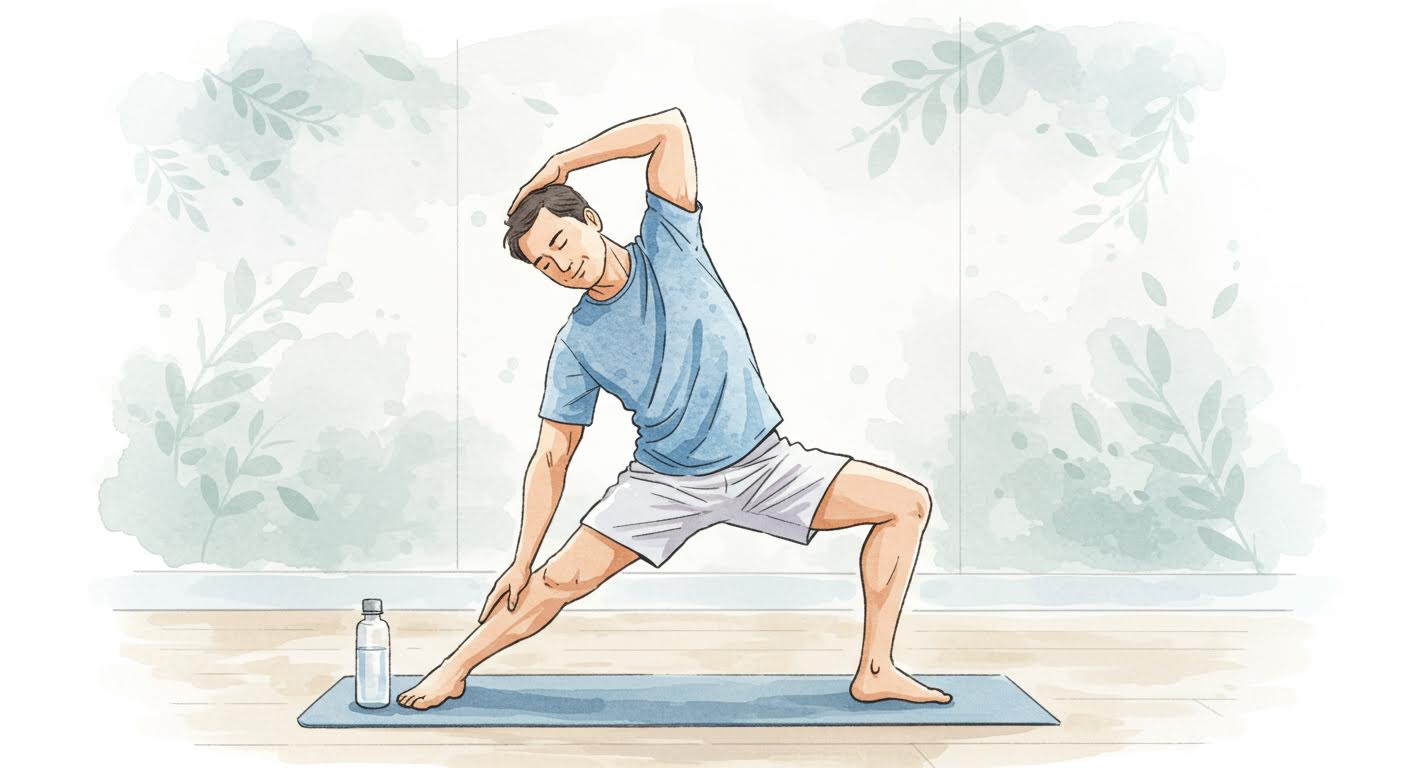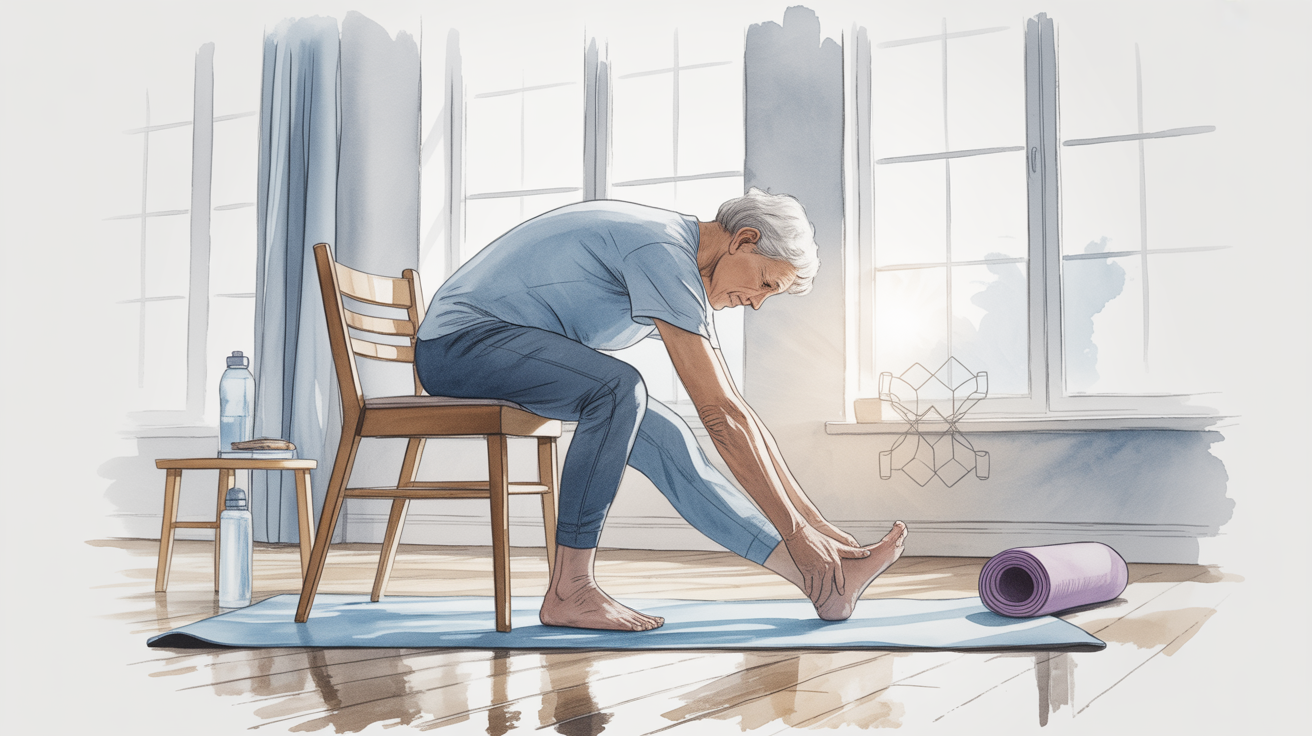Your alarm goes off and before you even sit up, that familiar lower back stiffness hits. Sound familiar? About 80% of adults experience lower back pain at some point, and for many, it starts the moment they wake up. The good news is that spending just 5 minutes on targeted morning stretches can dramatically reduce your chances of dealing with back pain throughout the day.
After years of waking up with a stiff back myself, I discovered that the right morning stretches routine makes all the difference. These seven specific movements target the key muscle groups that tighten overnight and contribute to lower back discomfort. What works is focusing on gentle movements that wake up your spine gradually rather than jumping straight into your day.
You’ll learn exactly which stretches to do, how long to hold each position, and why this particular sequence is so effective for preventing back pain. No equipment needed – just your body and 5 minutes of your morning.
Why Your Lower Back Hurts When You Wake Up
Understanding why morning back pain happens is the first step to preventing it. During sleep, your muscles and joints become stiff from staying in the same position for hours. Your spinal discs actually absorb fluid overnight, making them slightly larger and more prone to pressure when you first move.
Research from the American Physical Therapy Association shows that people who remain sedentary immediately after waking are 40% more likely to experience back pain throughout the day. Your hip flexors shorten, your glutes weaken, and your spine loses its natural mobility curve.
The solution isn’t complicated. Gentle morning stretches restore normal range of motion, increase blood flow to stiff tissues, and activate the deep core muscles that support your spine. Think of it as turning on your body’s natural support system before you ask it to handle the demands of your day.
The 5-Minute Morning Stretches Routine
This sequence follows a specific order designed to gradually mobilize your spine from lying down to standing. Each stretch targets different areas that commonly contribute to lower back pain: hip flexors, hamstrings, glutes, and spinal extensors.
Hold each stretch for 30-45 seconds, breathing deeply throughout. Don’t bounce or force any movement – your body needs time to warm up. If something feels uncomfortable, back off slightly until you find a gentle stretch sensation.
Stretch 1: Knee-to-Chest Pull
Start this routine right in bed before you even get up. Lying on your back, bring one knee toward your chest using both hands behind your thigh. This gentle movement begins to mobilize your lower back and hip flexors.
What makes this stretch so effective is that it creates space between your vertebrae while your spine is still supported. Hold for 30 seconds on each leg, then bring both knees to chest for another 30 seconds. You should feel a gentle release through your lower back and hips.
Stretch 2: Supine Spinal Twist
Still lying down, extend your arms out to form a T-shape. Bring your knees up to 90 degrees, then slowly lower them to one side while keeping your shoulders flat. This rotation is crucial for spinal mobility that gets lost during sleep.
Hold for 30 seconds on each side. If your knees dont reach the floor easily, place a pillow underneath for support. The key is the rotation, not how far you can twist. This movement helps realign your spine and releases tension in your thoracic region.
Stretch 3: Cat-Cow Stretch
Now it’s time to get on your hands and knees. This classic yoga movement gently mobilizes every segment of your spine. Start with a neutral spine, then arch your back while lifting your head (cow position), followed by rounding your spine toward the ceiling (cat position).
Move slowly through 8-10 repetitions. Research from the Journal of Bodywork Movement shows that spinal flexion and extension exercises reduce morning stiffness by up to 60%. Focus on moving one vertebra at a time rather than forcing the movement.
Stretch 4: Child’s Pose with Side Reach
From hands and knees, sit back onto your heels and reach your arms forward. This stretches your entire back chain and decompresses your spine. For the side reach variation, walk your hands to the right for 15 seconds, then to the left for 15 seconds.
This position is particularly effective because it combines spinal elongation with gentle lateral stretching. Many people hold tension in their quadratus lumborum muscle along the sides of their lower back, and this movement addresses that specific area.
Stretch 5: Standing Forward Fold
Time to stand up slowly. With feet hip-width apart, hinge at your hips and fold forward. Let your arms hang heavy or hold opposite elbows. This stretch targets your hamstrings, which when tight, pull on your pelvis and create lower back strain.
Don’t worry about touching the floor – that’s not the point. Focus on the stretch in the back of your legs and keep a micro-bend in your knees. Hold for 45 seconds, swaying gently from side to side if it feels good.
Stretch 6: Standing Hip Flexor Stretch
Step your right foot forward into a lunge position, keeping your back leg straight. Place your hands on your front thigh and gently press your hips forward. Your hip flexors shorten significantly during sleep, and this stretch is essential for restoring normal length.
Hold for 30 seconds on each side. You should feel the stretch in the front of your hip on the back leg. If balance is challenging, hold onto a wall or chair. Tight hip flexors are one of the biggest contributors to lower back pain that most people never address.
Stretch 7: Standing Back Extension
Finish with gentle back extensions. Place your hands on your lower back and slowly arch backward, looking up toward the ceiling. This movement counters all the forward flexion from sleeping and sitting.
Hold for 15-20 seconds and repeat 2-3 times. After spending hours in a flexed position, your spine needs to remember how to extend. This stretch activates your erector spinae muscles and helps restore your natural spinal curves.
Quick Takeaways
- Start stretching before getting out of bed – your spine needs gradual mobilization
- Hold each stretch for 30-45 seconds – rushing through defeats the purpose
- Follow the sequence in order – it progresses from lying to standing systematically
- Breathe deeply throughout – oxygen helps muscles relax and lengthen
- Never force or bounce – gentle, sustained stretches are most effective
- Do this routine daily – consistency matters more than intensity
- Listen to your body – back off if anything causes pain or discomfort
Common Mistakes to Avoid
The biggest mistake I see people make is rushing through their morning stretches routine. Your body has been static for 6-8 hours – it needs time to wake up gradually. Forcing deep stretches on cold muscles can actually cause more harm than good.
Another common error is skipping the routine when you’re running late. This might sound weird, but those are exactly the days when you need stretching most. A stiff, unprepared spine is much more likely to get injured during daily activities.
Don’t make the mistake of only stretching when you feel pain. Prevention is alot more effective than trying to fix problems after they develop. Consistency with these gentle movements creates lasting changes in your mobility and pain levels.
When to Modify or Progress Your Routine
Listen to your body’s feedback and adjust accordingly. If you have existing back injuries, consult with a healthcare provider before starting any new exercise routine. Some people need to start with even gentler modifications, especially those recovering from recent back episodes.
As your flexibility improves over several weeks, you might find you can hold stretches longer or move deeper into positions. However, the goal isn’t maximum flexibility – it’s optimal function and pain prevention. Sometimes less is actually more when it comes to morning mobility.
If you experience any sharp pain, tingling, or numbness during these stretches, stop immediately and seek professional guidance. These movements should feel good and create a sense of relief, not discomfort.
Building the Habit for Long-Term Success
The hardest part about any morning routine isn’t the movements themselves – it’s making them automatic. Start by setting your alarm just 5 minutes earlier and keeping the routine simple. Don’t try to be perfect; aim for consistency over perfection.
About 6 months ago, I started linking my stretching routine to something I already did every morning: making coffee. While the coffee brewed, I did my stretches. This habit stacking technique made the routine stick much faster than trying to remember it randomly.
Track your progress not by flexibility gains, but by how your back feels throughout the day. Most people notice significant improvements in their morning stiffness within 2-3 weeks of consistent practice. The long-term benefits of preventing back pain episodes make those 5 minutes incredibly worthwhile.
Frequently Asked Questions
Q – Should I do morning stretches even if my back doesn’t hurt?
A – Absolutely. Prevention is much more effective than treatment. These stretches maintain spinal mobility and prevent problems from developing rather than just addressing existing pain.
Q – Can I do these stretches if I have a herniated disc?
A – Consult your healthcare provider first. Some movements may need modification depending on your specific condition and which disc is affected.
Q – How long before I notice improvements in my back pain?
A – Most people experience reduced morning stiffness within 1-2 weeks. Significant pain reduction typically occurs after 3-4 weeks of consistent daily practice.
Q – Is it better to stretch before or after my morning workout?
A – This gentle routine works well before workouts as a warm-up. It prepares your spine for more demanding movement without fatiguing your muscles.
Q – What if I don’t have time for all seven stretches?
A – Focus on the first four stretches, which target the most critical areas. Even 2-3 minutes of gentle movement is better than none at all.
Bottom Line
Lower back pain doesn’t have to be an inevitable part of your morning routine. These seven targeted morning stretches address the root causes of morning stiffness and create a foundation for pain-free days. The investment of 5 minutes each morning pays dividends in improved mobility, reduced pain, and better quality of life.
Remember, the best exercise routine is the one you’ll actually do consistently. Start with this simple sequence, be patient with your progress, and trust the process. Your back will thank you for the attention, and you’ll wonder why you waited so long to make this small but powerful change to your morning routine.
Take action today – tomorrow morning, before you even get out of bed, start with that first knee-to-chest stretch. Your future self will appreciate the effort you put in now to prevent pain later.




